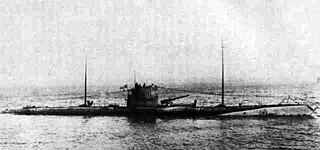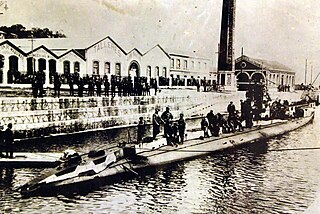
SM U-103 was an Imperial German Navy Type U 57 U-boat that was rammed and sunk by HMT Olympic during the First World War. U-103 was built by AG Weser in Bremen, launched on 9 June 1917 and commissioned 15 July 1917. She completed five tours of duty under Kptlt. Claus Rücker and sank eight ships totalling 15,467 gross register tons (GRT) before being lost in the English Channel on 12 May 1918.

SM UC-15 was a German Type UC I minelayer submarine or U-boat in the German Imperial Navy during World War I. The U-boat was ordered on 23 November 1914, laid down on 28 January 1915, and was launched on 19 May 1915. She was commissioned into the German Imperial Navy on 28 June 1915 as SM UC-15. Mines laid by UC-15 during her eight patrols are credited with sinking 3 ships. UC-15 disappeared in November 1916.
SM UB-22 was a German Type UB II submarine or U-boat in the German Imperial Navy during World War I. The U-boat was ordered on 30 April 1915 and launched on 9 October 1915. She was commissioned into the German Imperial Navy on 2 March 1915 as SM UB-22. The submarine sank 27 ships in 18 patrols for a total of 16,645 gross register tons (GRT). UB-22 was mined and sunk in the same incident with the torpedoboat SMS S16 in the North Sea at 54°40′N6°32′E on 19 January 1918 in a British minefield.
SM UB-30 was a German Type UB II submarine or U-boat in the German Imperial Navy during World War I. The U-boat was ordered on 22 July 1915 and launched on 16 November 1915. She was commissioned into the German Imperial Navy on 18 March 1916 as SM UB-30.
SM UC-17 was a German Type UC II minelaying submarine or U-boat in the Imperial German Navy in World War I. She was ordered on 29 August 1915 and launched on 29 February 1916. She was commissioned into the Imperial German Navy on 21 July 1916 as SM UC-17.
SM UC-20 was a German Type UC II minelaying submarine or U-boat in the German Imperial Navy during World War I. The U-boat was ordered on 29 August 1915 and was launched on 1 April 1916. She was commissioned into the German Imperial Navy on 7 September 1916 as SM UC-20. In 13 patrols UC-20 was credited with sinking 21 ships, either by torpedo or by mines laid. UC-20 was surrendered on 16 January 1919 and broken up at Preston in 1919–20.
SM UC-22 was a German Type UC II minelaying submarine or U-boat in the German Imperial Navy during World War I. The U-boat was ordered on 29 August 1915 and was launched on 1 February 1916. She was commissioned into the German Imperial Navy on 30 June 1916 as SM UC-22. In 15 patrols UC-22 was credited with sinking 23 ships, either by torpedo or by mines laid. UC-22 was surrendered to France on 3 February 1919 and was broken up at Landerneau in July 1921.
SM UC-23 was a German Type UC II minelaying submarine or U-boat in the German Imperial Navy during World War I. The U-boat was ordered on 29 August 1915 and was launched on 29 February 1916. She was commissioned into the German Imperial Navy on 17 July 1916 as SM UC-23. In 17 patrols UC-23 was credited with sinking 46 ships, either by torpedo or by mines laid. UC-23 was surrendered at Sevastopol on 25 November 1918 and broken up at Bizerta in August 1921.
SM UC-25 was a German Type UC II minelaying submarine or U-boat in the German Imperial Navy during World War I. The U-boat was ordered on 29 August 1915 and was launched on 10 June 1916. She was commissioned into the German Imperial Navy on 28 June 1916 as SM UC-25. In 13 patrols UC-25 was credited with sinking 21 ships, either by torpedo or by mines laid. From March to September 1918, she was commanded by Karl Dönitz, later grand admiral in charge of all U-boats in World War II. UC-25 was scuttled at Pola on 28 October 1918 on the surrender of Austria-Hungary.
SM UC-31 was a German Type UC II minelaying submarine or U-boat in the German Imperial Navy during World War I. The U-boat was ordered on 29 August 1915 and was launched on 7 August 1916. She was commissioned into the German Imperial Navy on 2 September 1916 as SM UC-31. In 13 patrols UC-31 was credited with sinking 38 ships, either by torpedo or by mines laid. UC-31 was surrendered on 26 November 1918 and broken up at Canning Town in 1922.
SM UC-40 was a German Type UC II minelaying submarine or U-boat in the German Imperial Navy during World War I. The U-boat was ordered on 20 November 1915 and was launched on 5 September 1916. She was commissioned into the German Imperial Navy on 1 October 1916 as SM UC-40. In 17 patrols UC-40 was credited with sinking 30 ships, either by torpedo or by mines laid. UC-40 was being taken to surrender but foundered in the North Sea en route on 21 January 1919.
SM UC-45 was a German Type UC II minelaying submarine or U-boat in the German Imperial Navy during World War I. The U-boat was ordered on 20 November 1915 and was launched on 20 October 1916. She was commissioned into the German Imperial Navy on 18 November 1916 as SM UC-45. In five patrols UC-45 was credited with sinking 12 ships, either by torpedo or by mines laid. UC-45 sank in a diving accident on 17 September 1917 in the North Sea. The German salvage vessel Vulkan raised the wreck and UC-45 re-entered service on 24 October 1918. She was surrendered on 24 November 1918 and broken up at Preston in 1919–20.
SM UC-49 was a German Type UC II minelaying submarine or U-boat in the German Imperial Navy during World War I. The U-boat was ordered on 20 November 1915 and was launched on 7 November 1916. She was commissioned into the German Imperial Navy on 2 December 1916 as SM UC-49. In 13 patrols UC-49 was credited with sinking 26 ships, either by torpedo or by mines laid. UC-49 was sunk by mine off coast of Flanders on 14 August 1918.

SM UC-56 was a German Type UC II minelaying submarine or U-boat in the German Imperial Navy during World War I. The U-boat was ordered on 12 January 1916, laid down on 4 March 1916, and was launched on 26 August 1916. She was commissioned into the German Imperial Navy on 18 December 1916 as SM UC-56. In six patrols UC-56 was credited with sinking one ship by torpedo: the British hospital ship HMHS Glenart Castle. UC-56 suffered from mechanical breakdowns that prevented her from submerging. She put in at Santander, Spain, on 24 May 1918 and was interned there for the duration of the war.
SM UC-79 was a German Type UC II minelaying submarine or U-boat in the German Imperial Navy during World War I.

SM UB-64 was a German Type UB III submarine or U-boat in the German Imperial Navy during World War I. She was commissioned into the German Imperial Navy on 5 August 1917 as SM UB-64.

SM UB-73 was a German Type UB III submarine or U-boat in the German Imperial Navy during World War I. She was commissioned into the German Imperial Navy on 2 October 1917 as SM UB-73.

SM UB-78 was a German Type UB III submarine or U-boat in the German Imperial Navy during World War I. She was commissioned into the German Imperial Navy on 20 October 1917 as SM UB-78. Mined off Dover on 19 April 1918 all 35 crew lost.

SM UB-89 was a German Type UB III submarine or U-boat in the German Imperial Navy during World War I. She was commissioned into the German Imperial Navy on 25 February 1918 as SM UB-89.

SM UB-148 was a German Type UB III submarine or U-boat built for the German Imperial Navy during World War I. She was commissioned into the German Imperial Navy on 19 September 1918 as UB-148. UB-148 was surrendered to the United States in accordance with the requirements of the Armistice with Germany on 1 December 1918 and later sunk as target by USS Sicard.





